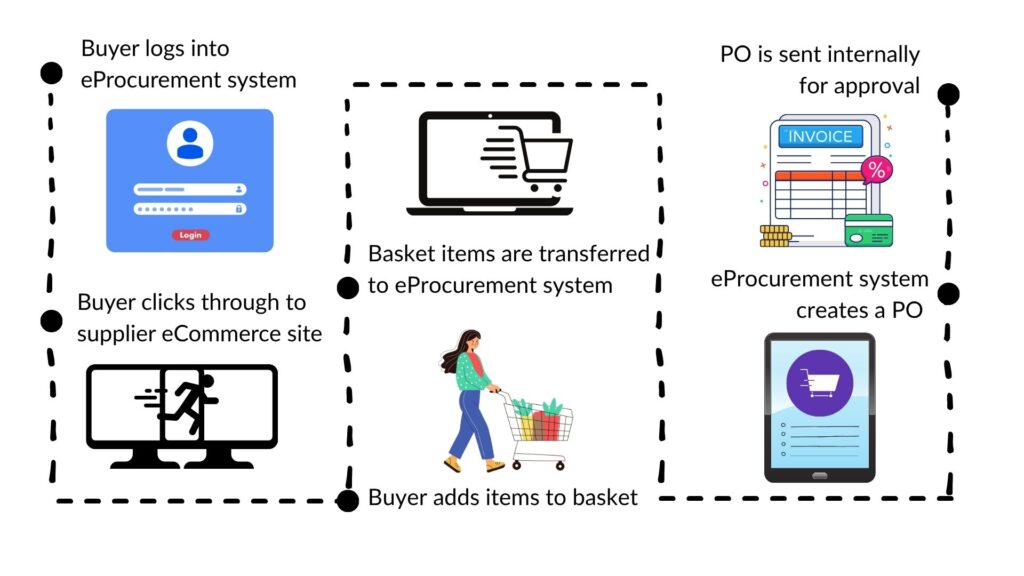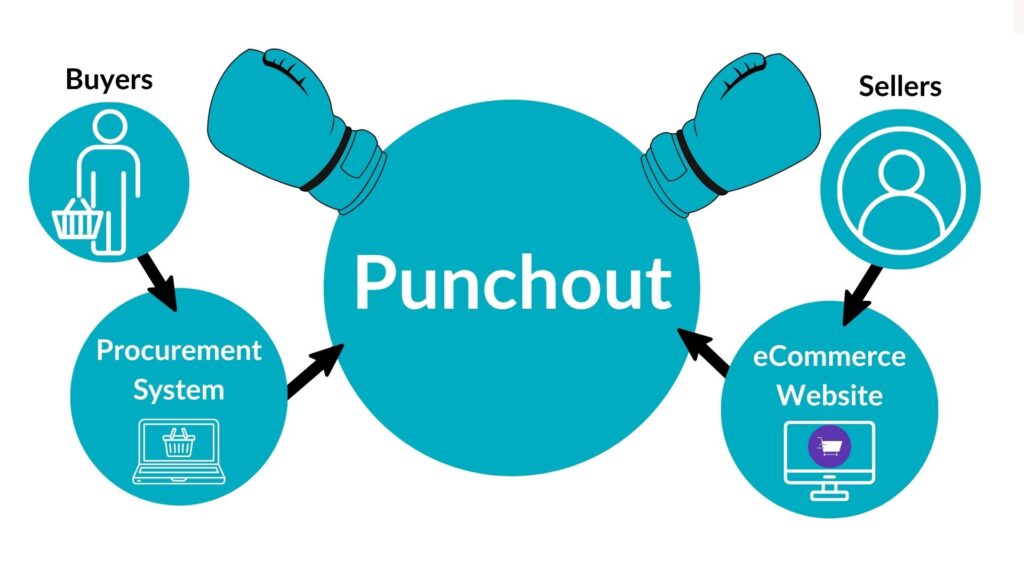
You know that feeling when a big client asks about "punchout capabilities" and you nod along whilst frantically Googling what they mean? We've all been there. B2B eCommerce has this quirky problem where everyone wants to buy online, but the actual buying process is still often a mess of spreadsheets and manual data entry.
Approximately 2/3rds of B2B buyers prefer buying online, but there's a catch. The average B2B order still involves 3+ people, 2 spreadsheets, a PDF quote, and someone manually typing in a PO. That disconnect between preference and process is exactly where punchout solutions come in.
If you have large clients continuously asking for integrations with their procurement systems, or you're losing deals because your checkout process doesn't fit their approval workflows, punchout might be the missing piece. The harsh reality? Some big clients won't even consider suppliers who can't connect to their procurement systems.
What is a punchout solution? Picture this scenario – your customer's procurement team could shop on your website without ever leaving their system. That's basically what punchout does.
So, what makes it clever? Well, imagine someone in purchasing logs into their company's procurement system (SAP Ariba, Oracle iProcurement, etc). They then spot a button or link next to your company name and click it. Suddenly, they’re on your website, browsing products just like any other customer… This means your customer can add items to their basket, go through checkout, and find themselves back in their procurement system with everything they need. That includes product details, pricing, specifications and more already populated at the user’s purchase request.
No copying and pasting product codes. No re-typing descriptions. No "is this the right price?" conversations several days later.
The tech behind this uses things like cXML and OCI protocols. These are the agreed-upon languages that let different systems talk to each other. cXML is the common one. Think of it as the translator between your Magento site and their SAP system.
The cXML (commerce eXtensible Markup Language) protocol is probably the most common. The cXML PunchOut catalogue integration simplifies sourcing by allowing access to supplier catalogues directly within their eProcurement system. SAP originally created OCI (Open Catalogue Interface) for their own systems, but other procurement platforms have since adopted it. The real advantage here is that everything updates in real-time. Your customers see current stock levels, today's pricing, and the latest product specs when they browse your site. Gone are the days of working from last month's catalogue only to discover the prices have changed or something's out of stock.
What makes this powerful is the real-time aspect. When your customer punches out to your site, they're seeing live stock levels, current pricing, and accurate product information. No more outdated catalogues or pricing discrepancies that cause headaches down the line.

Here's the typical scenario: Your customer's procurement team hunts down your latest PDF catalogue (assuming they can locate the current version), then someone manually enters product codes, descriptions, and prices into their system. They submit the purchase order, which usually contains at least one mistake or outdated detail.
Everyone gets frustrated. The finance team struggles to track spending properly. Procurement staff spend their day on data entry when they should be negotiating better deals. Meanwhile, you're fielding calls about incorrect orders, arguing over prices, and waiting longer for payments.
PunchOut eliminates most of these pain points through automation. Cart data transfers seamlessly, so no more double data entry. Approval workflows happen within the customer's existing system, maintaining their governance processes. Real-time budget tracking becomes possible because the procurement system knows exactly what's being purchased and at what cost.
There's also the password problem. How many times have your B2B customers forgotten their login credentials or struggled with account access? With punchout, authentication happens through their procurement system - they're automatically logged in when they punch out to your site.
The compliance aspect can't be ignored either. The future will see Punchout solutions that allow seamless communication between procurement departments and suppliers, ensuring transactions are processed quickly without unnecessary manual work. For companies with strict audit requirements, having a clear digital trail through their procurement system is invaluable.
According to a recent McKinsey report, eCommerce accounts for over a third of B2B revenue for companies offering it from 2024. But offering a platform for online sales isn’t enough. Many businesses require eCommerce solutions that seamlessly integrate with their existing systems.
We've seen this problem and requirement firsthand with one of our public sector clients. Stone Computers has a PunchOut solution through TradeCentric as part of a contractual agreement. Their customers can now place orders through their preferred procurement systems, leading to easier order placement.
The customer retention aspect is particularly striking. Many larger organisations simply won't do business with suppliers who can't support their procurement workflows. It's not about being difficult either; it's about maintaining the controls and processes that keep their businesses running smoothly.
From a sales perspective, punchout capability often leads to increased order values. When the ordering process is streamlined and integrates with approval workflows, buyers are more likely to consolidate purchases and take advantage of volume pricing. The friction that typically causes buyers to split orders across multiple suppliers gets removed.
There's also a competitive differentiation factor. While punchout solutions are becoming more common, many B2B suppliers still don't offer this capability. Having punchout integration can be the deciding factor when enterprise buyers evaluate potential suppliers.
The operational benefits extend beyond just winning new business. Punchout orders typically require less manual intervention, leading to faster order processing and fewer customer service requests. When order data comes through cleanly formatted and accurate, your fulfilment team can focus on getting products out the door rather than clarifying specifications.

Here's where many B2B businesses get stuck. Popular eCommerce platforms like Magento, Shopify, or WooCommerce don't have built-in punchout capabilities. You'll need to work with a third-party integration partner that specialises in connecting eCommerce platforms with procurement systems.
Getting started means figuring out what procurement systems your customers actually use. You'll probably encounter SAP Ariba, Oracle iProcurement, and Coupa regularly, though there are easily 100+ different eProcurement platforms out there depending on your industry.
After picking an integration partner, expect plenty of back-and-forth between your developers, the integration company, and your customer's IT people. Someone needs to sort out how the systems will authenticate users, map data fields correctly, and establish the communication pathways that make punchout work.
Then it’s time for the testing phase. Use your staging environment where you can run through the entire process before customers start using it. You're not just checking that the technical bits work, but making sure that jumping between systems doesn't feel clunky or confusing.
Magento 2 can connect to external procurement systems through punchout integrations, letting you build B2B catalogues that work with cXML and OCI protocols. Adobe Commerce works similarly, though you might need more customisation if you're dealing with complicated product configurations or tiered pricing.
The implementation is typically done on a customer-by-customer basis. Each procurement system has its own requirements and authentication methods. What works for one customer's SAP Ariba setup might need adjustments for another customer's Oracle system.
Your team will need some time to get comfortable with how everything works. Customer service reps should understand how punchout orders move through your system, and your IT folks need to know enough to keep the integrations running properly. Yes, there's an upfront investment in training and setup, but it's worth it once you see how smoothly everything operates.
PunchOut has moved from "that would be nice" to "we need this to compete" for B2B eCommerce businesses targeting enterprise clients. Your customers keep asking about it because it actually fixes the annoying parts of their purchasing process – no more copying data between systems, and their approval workflows stay intact.
The barriers to implementing punchout solutions have come down significantly. With the right integration partner and a clear plan, adding punchout capability is more accessible than many B2B businesses realise. The question isn't whether to utilise PunchOut, but how quickly you can get started.
If you're already working with larger customers, you'll probably see the payback within a few months. Bigger orders, fewer support headaches, and customers who stick around longer – these benefits usually cover what you spent on setup pretty quickly.
Want to build out your B2B capabilities further? As an established B2B development agency, our team has the expertise to help your eCommerce business. And if you’re thinking of adding punchout to your B2B store, then we can help with integration options that match your business size and technical setup. We typically work with Magento Open Source and Adobe Commerce when doing punchout work, and we've helped businesses tackle the technical hurdles to build solutions that work for everyone involved.
Get in touch with us at magic42 for more Magento B2B eCommerce assistance or B2B eCommerce services.



